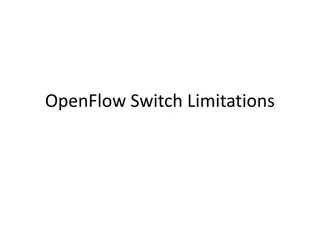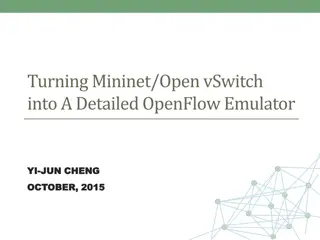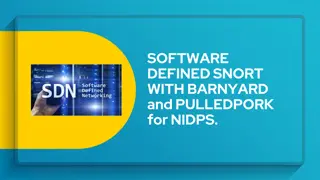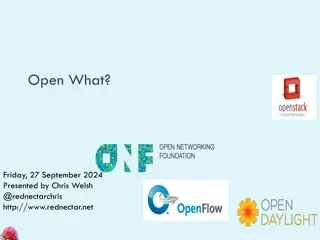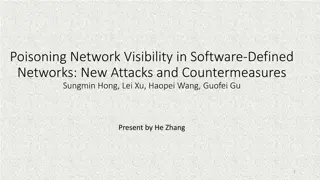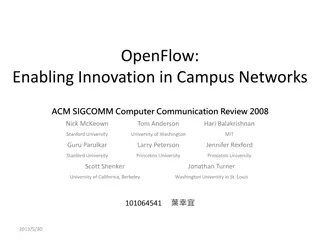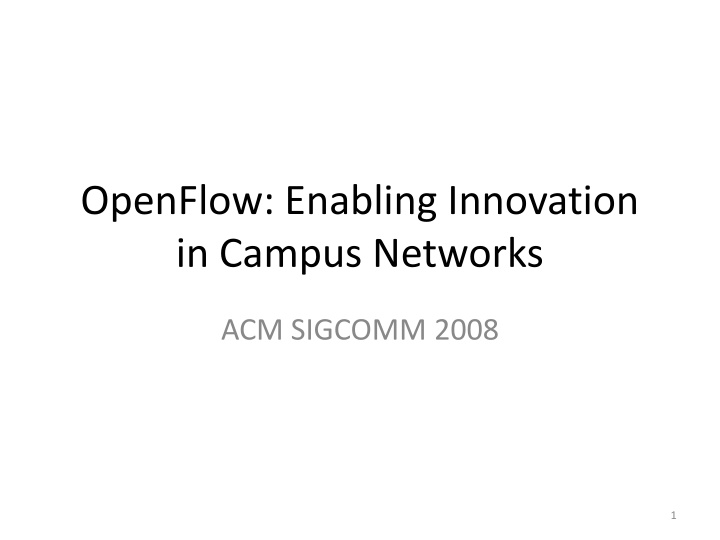
Innovation in Campus Networks with OpenFlow Protocol
"Explore how OpenFlow protocol enables innovation in campus networks by providing programmable and experimental capabilities, addressing the need for research solutions and promoting network protocol experimentation. Learn about the OpenFlow switch and its components for network programmability and control."
Download Presentation

Please find below an Image/Link to download the presentation.
The content on the website is provided AS IS for your information and personal use only. It may not be sold, licensed, or shared on other websites without obtaining consent from the author. If you encounter any issues during the download, it is possible that the publisher has removed the file from their server.
You are allowed to download the files provided on this website for personal or commercial use, subject to the condition that they are used lawfully. All files are the property of their respective owners.
The content on the website is provided AS IS for your information and personal use only. It may not be sold, licensed, or shared on other websites without obtaining consent from the author.
E N D
Presentation Transcript
OpenFlow: Enabling Innovation in Campus Networks ACM SIGCOMM 2008 1
Introduction THE NEED FOR PROGRAMMABLE NETWORKS 2
The Need For Programmable Networks Today, there is almost no practical way to experiment with new network protocols The scale is not big enough to gain confidence Kind of a vicious circle Virtualized programmable networks could lower the barrier to entry for new ideas. Networking community is working on a nationwide solution Such as GENI But it ll take years to deploy 3
The Need For Programmable Networks This paper focus on a shorter-term question As researchers, how can we run experiments in campus network? Goal: purpose a new switch feature that extend programmability Commercial solutions are too closed, inflexible Research solutions either have insufficient performance/fanout, or are too expensive 4
The Need For Programmable Networks Solution: compromise on generality Amenable to high-performance and low-cost implementations Capable of supporting a board range of research Assured to isolate experimental traffic from production traffic Consistent with vendors need for closed platforms 5
The Openflow Switch Most Ethernet switch contain flow-tables Typically built from TCAMs, run at line-rate Identify a common set of function and exploit them Openflow is an open protocol to program the flow-table in different switches and routers Network administrator can isolate experiment traffic from regular ones Researcher can control their own flow 7
The Openflow Switch Consist of at least three parts A flow table with an action associated with each entry A secure channel Connects the switch with a remote control process(Controller) The OpenFlow Protocol 8
Flow Entry in Flow Table Packet header 10-tuple in first generation Type 0 switch Each field can be a wildcard Associated action Statistics # of packet, bytes for each flow etc. 10
Associated Action A: Forward this flow s packet to a given port(s) Allow packets to be routed through the network B: Encapsulate and forward to a controller Delivered to secure channel Typically for the first packet in a flow C: Drop this flow s packets D: Forward this flow s packets through normal processing pipeline 11
Associated Action Dedicated OpenFlow switches A dumb datapath element that forwards packets between ports, as defined by remote controller Support action A to C OpenFlow-enabled switches A functional router/switch that s enhanced with OpenFlow Reuse some of it s hardware(such as TCAMs) Support action A to C Support action D or use VLANs to differentiate 12
Associated Action Those that supports the minimum required action mentioned earlier is called type 0 switch. Some switch will support some extra features, these are called type 1 switch. 14
Controller A controller adds and removes flow-entries A simple static controller Just establish flows to interconnect a set of test computers for the duration of the experiment Isolate experimental traffic from normal ones Generalization of VLANs There can be some more sophisticated controllers Dynamically add/remove flows in the progress of the experiment Share the network between multiple researchers 15
Using OpenFlow Ex: Amy want to test her new Amy-OSPF routing protocol The Amy-OSPF will run in a controller Each time a new flow starts, the Amy-OSPF will pick a route All the following packets will be forwarded accordingly Amy can limit this action only to the packet coming from her own computer s port 17
Using OpenFlow Question: can such a centralized controller be fast enough to process new flows and program the Flow Switches? A part of this question is answered in Ethane prototype(ACM SIGCOMM 2007) A low-cost commodity PC can handle over 10000 new flows per second Enough for campus 18
Experiments in a Production Network Two important properties Packets belonging to other users should be routed normally Amy should only be able to add flow entries for the traffic she is allowed to control First one is achieved by OpenFlow-enabled switches Second one depends on controller implementation 19
Some more examples Network Management and Access control VLANs Mobile wireless VOIP clients User a controller that track the user s location, and do the handoff by changing the flow-tables Non-IP network Can use Ethernet header, Ethernet type or new non-IP protocols 20
Some more examples Processing packets rather than flows Forward every packets to controller at the cost of performance Route them to a programmable switch, such as NetFPGA 21
Conclusion OpenFlow is a pragmatic compromise Allow researches to run experiments on heterogeneous switches and routers in a uniform way Vendors don t have to expose their internal working Researchers don t have to write vendor-specific programs Hoping that new generation of control software will emerges Accelerating the innovation in networking 22
Backup Slides What is VLAN? http://s90304a123.pixnet.net/blog/post/3879 3827-ccna%E6%95%99%E5%AD%B8-vlan 23






